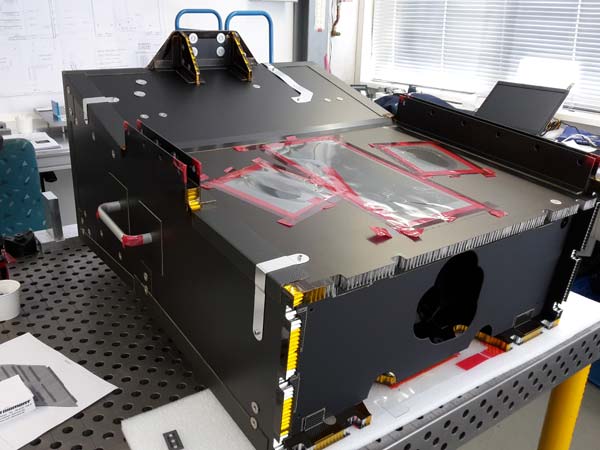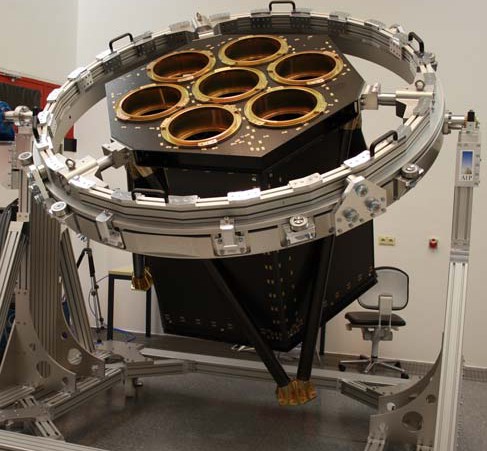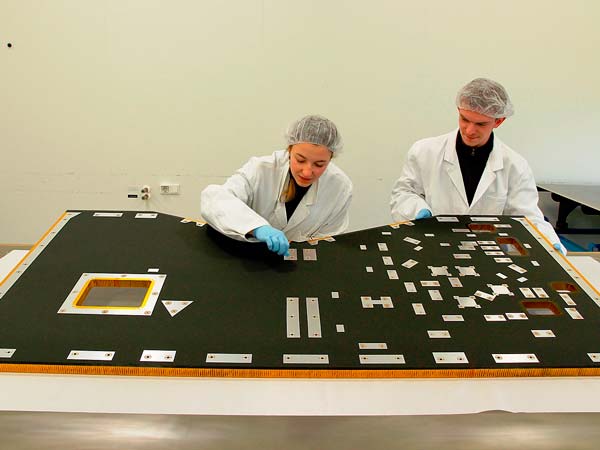The Sentinel 4 UVN OIMS consists of CFRP sandwich panels, monolithic CFRP, GFRP and metallic parts. The Nadir Baffle (service temp. 140 °C) incl. CFRP vanes is fully bonded by adhesive. The TSA hexapod structure is made of CFRP struts incl. Titanium fittings.
Archives: Projekte
Primary structure
The eROSITA structure is mainly built out of adhesive bonded CFRP/Aluminum sandwich panels for the optical bench and Aluminum/Aluminum sandwich panels for radiators. Further on, CFRP struts (hexapod for opt. bench), GFRP struts for the radiator truss work and monolithic CFRP parts have been developed and assembled by INVENT.
Primary and tertiary structures
The ExoMars load-bearing structure of the orbiter mainly consists of CFRP & aluminum sandwich with
>5300 metallic inserts, heterogeneous aluminum cores, structural and thermal doublers, grounding and painting (next to the central tube – not by INVENT). Additionally various CFRP, aluminum and titanium brackets for reaction wheels, LGA, He-tanks and star trackers were developed and manufactured
MGSE (Mechanical Ground Support Equipment)
MGSE Transport Container for Small Satellites / Instruments
The container system of Astro- und Feinwerktechnik Adlershof GmbH is individually suited to the size of your satellites or instruments. Our assurance of safe transportation goes without saying.
With these premises, we offer you optimal solutions for your transportation needs
- hermetically sealed inner areas
- defined gas atmospheres
- vibration-reduced transportation
- data connections for data recording during transport
- adapters for transport systems (Euro / ISO pallets, lifts)
Deployable Booms for satellites
As the outer segments and the complete boom fold out separately, there are only two degrees of freedom during each fold-out procedure; only three degrees of freedom in the case of spin-stabilized satellites.
The design principle of the Double Star boom can be adapted to a variety of spinstabilized satellites. A concept for an active, springdriven deployment, using redundant deployment springs at the hinges is available for non-spinning satellites.
Both versions can be realized either with one or two boom segments. The length of the deployed boom can be extended to more than four meters, depending on the dimensions of the spacecraft and on the mass to be deployed.
fold-out solar panel structures
a panel structure consisting of 3 panels, development of a fold-out system with four exact constructional replicas and completely independent solar panels for small satellites
ACS Test Facility for the verification of micro and mini satellite busses
The ACS Test Facility includes:
- air bearing table with a platform allowing free 360° rotation around the vertical axis and between 20° and 30° around the horizontal axes
- high precision in-orbit earth magnetic field simulation
- electronic center of gravity (CoG) calibration
- adjustable and movable sun simulation
- WLAN command line
- safety mechanisms for save operation and satellite mounting
- power supply and distributio
The PicoSatellite Launcher (PSL) family is designed to ensure the safety of the CubeSat and to protect the launch vehicle (LV)
the primary payload and other satellites to be launched. After the safe transportation of the device into the orbit, a deployment with a high reliability and a low spin rate is achieved by patented design principles. After a successful deployment, a telemetry signal is available for the launch provider.
The family of CubSat Deployer consists of the Single Picosatellite Launcher (SPL), the Double Picosatellite Launcher (DPL) and the Triple Picosatellite Launcher (TPL). The SPL is used to deploy one 1U CubeSat. The DPL is used to deploy one 2U CubeSat or two 1U CubeSats etc. The product line relies on a modular and redundant design
The ASG-1 is a high integrated rate sensor for space applications
It is designed especially for small satellite applications. Outstanding features are low mass and size as well as the low energy consumption. The ASG-1 measures angular increments in three orthogonal axes. Using these angular increments, the rotation speed of the satellite and the relative position of the satellite in relation to a starting point are calculated.





